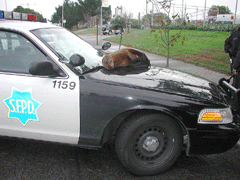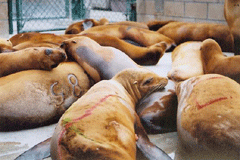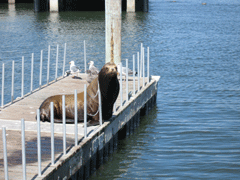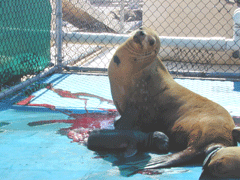Sea Lion Seizures
Air Date: Week of January 23, 2009

A sea lion disoriented from brain damage due to Domoic Acid poisoning. (Courtesy of the Marine Mammal Center)
In Alfred Hitchcock’s movie “The Birds,” crazed avians attack people in Santa Cruz, California, inciting panic. Now, something similar is happening in real life, and scientists think they may have discovered why. Amy Coombs reports.
Transcript
[SOUNDS OF ALFRED HITCHCOCK’S “THE BIRDS”]
CURWOOD: Few scenes in movies are scarier than the attacks of the vicious avians in Alfred Hitchcock’s thriller “The Birds”
[FROM MOVIE: “I THINK THESE WERE CROWS. YES, HUNDREDS OF THEM. YES, THEY ATTACKED THE CHILDREN, ATTACKED THEM.”]
CURWOOD: In the 1963 thriller, crazed birds terrorize residents of the northern California coast.
Though the film was based on a short story, it may have also been influenced by a real life bird poisoning that occurred just a few miles from the home of Alfred Hitchcock. Since then similar cases have been documented around the world.
And scientists now believe they have identified an ocean toxin that causes suffering and erratic behavior in marine animals. Amy Coombs has the story.
COOMBS: In 1961, about two years before the movie “The Birds” was released, real life residents in the beach town of Capitola awoke to birds slamming into their rooftops. The suburb of Santa Cruz was covered with dead sea birds and bits of disgorged fish. But University of California, Santa Cruz professor Raphael Kudela says unlike in the film, the birds weren’t trying to hurt anyone.

Sick sea lions at the Fort MacArthur Marine Mammal Center. (Courtesy of the Fort MacArthur Marine Mammal Center)
KUDELA: The movie suggested they were actually attacking people. What was probably happening is they were poisoned and they were disoriented and they’re just simply flying into things.
COOMBS: According to the local paper, Alfred Hitchcock did request news reports to use as “research material for his latest thriller.” At the time, people thought the birds had lost their way in the fog. But scientists now say domoic acid—a toxin produced by sea algae--is to blame for the strange behavior.
KUDELA: Domoic acid is a neurotoxin and so if you get enough of it in humans or in marine mammals, it actually causes brain damage. And it comes and goes, and every few years we have a big outbreak. Often times there will be deaths of California sea lions or dolphins or brown pelicans.
COOMBS: More and more sea animals are being poisoned by domoic acid. Each year the toxin kills hundreds of California sea lions that eat contaminated fish. Veterinarian Frances Gulland and her staff see the suffering at their rescue center located at the North end of the Golden Gate Bridge.
[SOUND OF SICK ANIMAL BLEATING]

A California Sea Lion takes a break from swimming. (Photo: Raphael Kudela, Courtesy of the University of California, Santa Cruz)
GULLAND: Do you want influenza? – Oh yes, are there forms in there? I guess I am going to run and go get some – Can we move that animal to C5?
This is the one that was having seizures and was picked up on the beach yesterday.
COOMBS: Domoic acid binds tightly to excitatory neurons, and causes a range of erratic behavior. As volunteer Lee Jackarel prepares a mesh net, he says sick sea lions are also extremely sensitive, and prone to over react when approached.
JACKAREL: So we have a long thin net that we will put over his head that helps constrain his movements so it’s easier to restrain him. And he will not enjoy that and he will try to get away from us and probably yell at us a bit and try to bite us.
COOMBS: As the researchers walk into the chain link enclosure, the sea lion spasms and tries to run away. Once trapped in the net, it takes five researchers to hold down his fins, take blood and administer treatments.

Sea lion with premature pup. (Courtesy of the Marine Mammal Center)
[SEA LION BARKING]
COOMBS: Despite the creature's misery, Gulland says this sea lion is lucky. In many cases the debilitating seizures cause so much brain damage that the animal dies. This is why more than half of the rescues have to be put to sleep, and many more die unnoticed at sea. Again veterinarian Frances Gulland:
GULLAND: Currently in California it’s probably the commonest form of disease in the animals we see, so I would say it’s the most important threat. And interesting thing, or the reason to be concerned is it doesn’t just cause seizures in adult animals, but it also crosses the placenta in pregnant females and can damage the developing fetus. So it can cause abortions and it can cause death of the newborn pup.
COOMBS: Scientists have known for a long time that domoic acid is produced by a sea algae, or plankton, called Pseudo-nitzschia. But that only happens only sometimes. The algae is usually benign. The question that has plagued them is what makes the plain algae suddenly start producing the toxin?
[LABS SOUNDS]
COOMBS: This is why Raphael Kudela’s lab is filled with beakers of Pseudo-nitzchia. Kudela shakes a bottle of the filmy algae. He says he thinks a form of nitrogen called urea makes the algae produce the toxin.
KUDELA: This is Pseudo-nitzchia. Pseudo-nitzschia multiseries will double its toxicity when we give it urea to grow on.
[LAB SOUNDS]

A sea lion disoriented from brain damage due to Domoic Acid poisoning. (Courtesy of the Marine Mammal Center)
[LAB SOUNDS]
COOMBS: So far, Kudela says, urea is the only chemical he's found that makes the algae increase its domoic acid production.
[LAB SOUNDS]
COOMBS: Having identified urea, the next question was whether it was present in the ocean. Kudela took water samples, and it turns out that urea levels are high enough to cause a problem.
KUDELA: When we measured things at the Santa Cruz Municipal Warf, or in the San Francisco Bay, we can measure quite high concentrations of urea. Often times it can be the largest source of nitrogen in the water.
COOMBS: Those findings appear in the November issue of the journal Harmful Algae. So the burning question now is: Where is all the urea coming from? James Cloern, a biologist at the US Geological Survey says that with urea, the arrows usually point to humans.
CLOERN: When we think of urea – which is an excretory waste product of vertebrates – we think of things like untreated sewage or runoff from animal feedlots.
COOMBS: Northern and Central California do have livestock, as well as people living with older, perhaps leaky septic systems. Urea can also come from garden fertilizers, like Miracle-Gro. Cloern says we’re still figuring out what's causing the increase in domoic acid poisonings.
CLOERN: This new work is important because it gives us a strong clue that one of those factors is the presence of urea, which we associate with land sources.
COOMBS: Some researchers like Kudela and the veterinarian Gulland hope we won't have to wait for certainty. They hope coastal communities will begin to watchdog urea pollution as a precaution. For Living on Earth, I’m Amy Coombs.
Living on Earth wants to hear from you!
Living on Earth
62 Calef Highway, Suite 212
Lee, NH 03861
Telephone: 617-287-4121
E-mail: comments@loe.org
Newsletter [Click here]
Donate to Living on Earth!
Living on Earth is an independent media program and relies entirely on contributions from listeners and institutions supporting public service. Please donate now to preserve an independent environmental voice.
NewsletterLiving on Earth offers a weekly delivery of the show's rundown to your mailbox. Sign up for our newsletter today!
 Sailors For The Sea: Be the change you want to sea.
Sailors For The Sea: Be the change you want to sea.
 The Grantham Foundation for the Protection of the Environment: Committed to protecting and improving the health of the global environment.
The Grantham Foundation for the Protection of the Environment: Committed to protecting and improving the health of the global environment.
 Contribute to Living on Earth and receive, as our gift to you, an archival print of one of Mark Seth Lender's extraordinary wildlife photographs. Follow the link to see Mark's current collection of photographs.
Contribute to Living on Earth and receive, as our gift to you, an archival print of one of Mark Seth Lender's extraordinary wildlife photographs. Follow the link to see Mark's current collection of photographs.
 Buy a signed copy of Mark Seth Lender's book Smeagull the Seagull & support Living on Earth
Buy a signed copy of Mark Seth Lender's book Smeagull the Seagull & support Living on Earth

